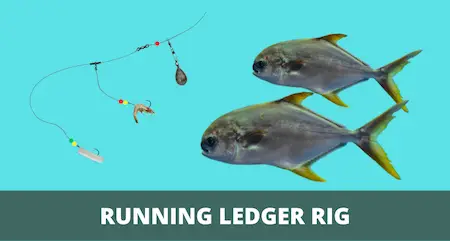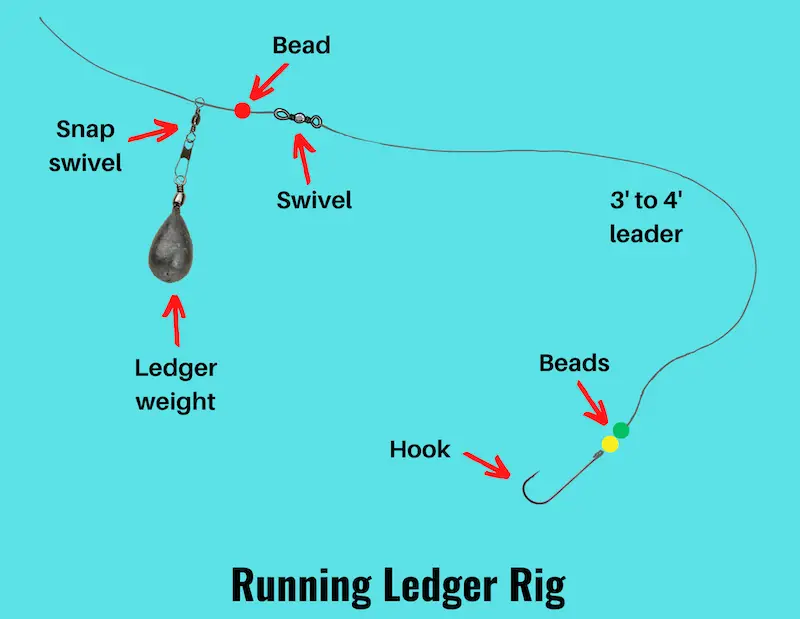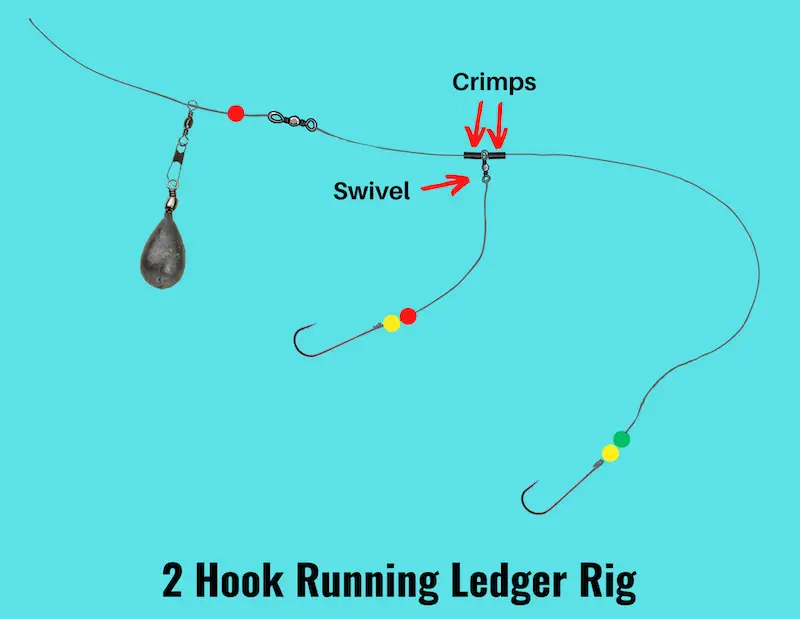Running Ledger Rig (Setup and Fishing Guide with Pictures)
PUBLISHED 16 AUGUST 2023
by Robert Ceran
Are you planning to throw a running ledger rig, but aren’t sure how to set it up, or how to fish it for optimal results?
While the running ledger is a great saltwater rig for surf fishing and boat fishing, it can be a little tricky to set up and fish correctly.
In this article I’ll show you how to set up a running ledger rig, and will aso cover what bait to use with it, and how to fish it for the best results.

What is a running ledger rig (and what is it good for)?
A running ledger rig is a setup for bottom fishing that consists of a sliding ledger weight, swivel, and a leader tied to either one or two hooks.
Also called a running rig, running sinker rig, or running ledger, this is a great saltwater setup for surf fishing and boat fishing.
The great thing about the sliding ledger rig is that a fish can swim with the bait for a while before it feels resistance, as the weight is able to slide on the line.
The running sinker rig is mostly fished with cut bait, but also works well with live bait, such as live shrimp or baitfish.
And while the running ledger setup is mostly used for saltwater fishing, a modified version of it is also used for northern pike fishing, since the double hook running ledger rig is ideal for presenting a dead baitfish on the bottom.
Running ledger rig components
Here are the tackle components that you’ll need for your running ledger rig setup:
- Barrel swivel
- Snap swivel
- Bank sinker (or equivalent)
- 20 to 100 lb test leader (monofilament or fluorocarbon)
- One or two hooks (Aberdeen hooks, J-hooks, or treble hooks)
- 10 mm Plastic beads (optional)
- Crimps (optional)
The plastic beads are not absolutely necessary, but can come in handy for two different purposes. A single bead can be rigged between the sinker and the swivel, which protects the knot on the swivel from being damaged.

And you can also rig 2 to 4 brightly colored beads right above the hook(s), which serve as attractors to bring in more fish.
And while I like to use a snap swivel to attach a sinker, another option is to use a plastic spreader or boom, as this can be useful for preventing line tangles with the weight.
How to tie a running ledger rig
In order to tie a simple running ledger rig, start by threading your main line through the eye of the snap swivel, followed by a plastic bead, and then tie the end of your line to the barrel swivel.
Now you can use the snap to attach any weight that has an eye, such as a bank sinker, torpedo lead, or ring-shaped gripper lead. And the great thing about this setup is that you can quickly exchange the weight, allowing you to adjust the size as necessary.
Next, measure out about 3 to 4 feet of leader line, and attach the end to your hook with a snell knot, followed by threading on two to four plastic beads (which serve as attractors).
Finally, tie the tag end to the other end of the barrel swivel, and you’re ready to start fishing.
If you want to rig a double hook running ledger sea rig, start the same way as with the simple setup. After attaching the hook to the end of the leader, thread a crimp, followed by swivel and then a second crimp onto the leader.

Position the swivel and the two crimps about 12 to 24 inches above the first hook, and then use a pair of pliers to pinch down the crimps. This process is very similar to that used to make a flapper rig.
Now tie the tag end of the leader to the barrel swivel that you attached to the end of your main line, and then tie a 12 inch leader to the crimped swivel.
If you like, thread a few beads onto the 12 inch leader, and then tie the tag end to the second hook.
Choosing the right leader length
The leader length depends on whether you’re casting this rig from the beach, or fishing it from a boat.
For surf casting, it’s generally best to keep your leader shorter than 3 to 4 feet, in order to avoid tangles during the cast.
However, if you’re fishing from a boat, you can used a longer leader up to 5 or 6 feet (or as long as the length of your rod), since the current will carry the baited hook away from the sinker, which will avoid spooking fish by the sight of your running lead rig.
What bait should you use with a running sinker rig?
The best bait to use with a running sinker fishing rig is cut bait, such as chunks of mackerel, herring, mullet, or shad.
When targeting smaller fish, another option is to use squid strips, sand fleas, cut crab, or shrimp. You can also use live shrimp on this rig.
How to fish a running rig
If you’re casting your rig from the shore, make sure you don’t tangle up your setup during the casting process (which is the bane of every surf angler).
After casting your rig out, wait for it to sink to the bottom and leave it in place for a while. Then retrieve it in short jerks, which helps to cover more ground in search of fish.

Image source: instagram/@fishbites
When boat fishing with a running rig, you can lower it straight down into the water until the weight hits the bottom.
However, make sure to lower it slow enough so the leader doesn’t get tangled with the main line and the sliding sinker.
The best way to use a running ledger boat rig is to fish it downtide, as that allows you to let your rig drift with the tide until it reaches bottom.
If you’re interested in more saltwater bottom rigs, check out our article on the Pompano rig.
